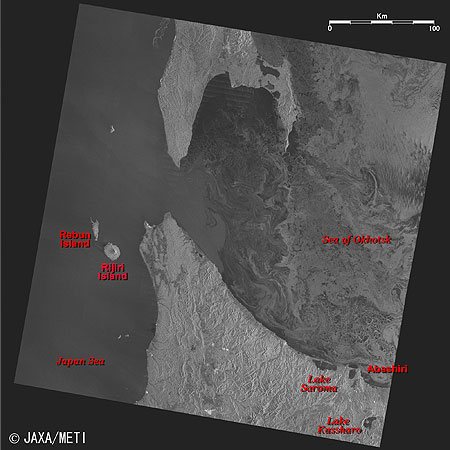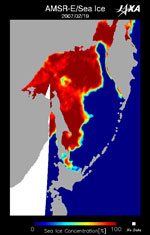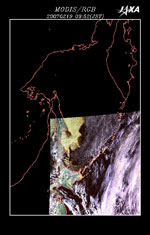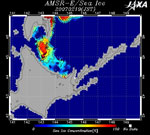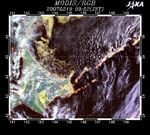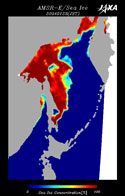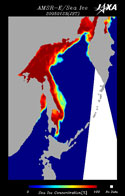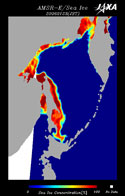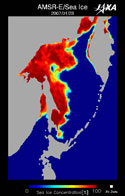Seen from Space 2007
The Coming of Sea-Ice Season 2007
The sea ice is approaching the coast of Hokkaido in the Sea of Okhotsk, but a narrow waterway still exists along the coast and you can see that the sea ice has not reached the coast. The First Regional Coast Guard Headquarters of the Japan Coast Guard announced that there is less sea ice near the coast of Hokkaido than usual. The Ice Information Center of the First Regional Coast Guard Headquarters of the Japan Coast Guard updates the status of sea ice in the Sea of Okhotsk. In addition, the observation data of PALSAR on Daichi will be used practically once a week from this year. PALSAR is a phased-array synthetic-aperture radar using L-band microwave signals to achieve cloud-free and day-and-night sea-ice observation. The Japan Meteorological Agency web site announced that the first sea ice of the season was observed on January 1, two days later than usual and that the first arrival of sea ice in the season was observed on February 16, 15 days later than usual in Abashiri-city. In Monbetsu city, according to the web site, the first sea ice was observed on January 26, four days later than usual, but the arrival of sea ice was not observed yet. Very little snow fell in the Japan Sea side of Japan this winter, and we experienced the spring-heralding gales in Tokyo before the first snowfall for the first time in Japanese climate monitoring history. Global warming in winter effects not only Japan but all countries worldwide. Global warming may also influence sea-ice trends in the Sea of Okhotsk.
In the AMSR-E image, the left side of Fig. 2, the red sea ice extends from off the eastern coast of Sakhalin to the south. To discriminate between sea ice and other features, sea ice is highlighted in red or orange. Greater sea ice concentrations are indicated by deeper shades of red. The MODIS image, the right side of Fig. 2, depicts yellow sea ice under white or bluish-gray clouds. The sea ice, which was formed off the Siberian coast northwest of the Sea of Okhotsk, 1,000 to 1,500km north of Hokkaido, flows to the south and is carried toward the coast of Hokkaido by the ocean current flowing off the eastern coast of Sakhalin.
The Sea of Okhotsk is the lowest frozen sea in latitude of all the seas in the world. The increase and decrease of the sea-ice extent is closely related to the climate, and this affects the catches of fish around the Islands of Japan. Therefore, it is very important to monitor the growth of the sea ice over the Sea of Okhotsk to determine the status and future condition of the global environment. The latest information on the sea ice extending to the Sea of Okhotsk is released on EORC's homepage "Sea-Ice Distribution in the Sea of Okhotsk," which has been updated daily since December 2003. It includes images of sea ice extending over the Sea of Okhotsk and the detailed distribution of sea ice approaching the coast of Hokkaido. You can also view changes in the sea-ice distribution by using the slide-show function.
|
||||||||||||||||||||||||||||||||||||||||||||||
